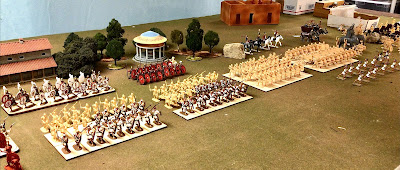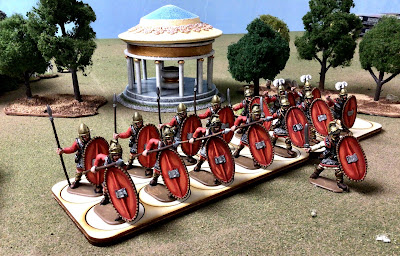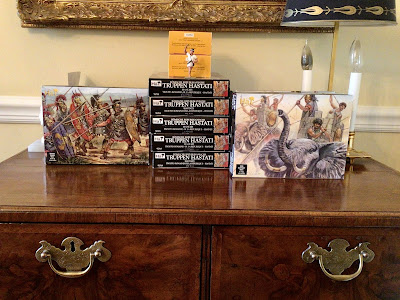Every once in awhile a good idea sneaks up behind and whacks you on the back of the head with a two by four ( a piece of lumber) in order to get your attention. I now have a huge lump on the back of my head where said piece of lumber knocked some common sense into me. Cue in the sounds of the fanfares as I present to you my new organization and basing for my Punic Wars Project.
Behold! I give you the new troop organizations
The infantry shall be based as fixed figures on multiple stands of 4 or 5 figures and a total number of figures at 30 per foot unit and 16 per skirmish unit. I haven't settled on the cavalry organization other than to know that they will be in groups or "squadrons" (squadrons probably didn't exist in 230BC, hence the use of air quotes) of 16 mounted figures. The cavalry will probably mounted two per stand with eight stands comprising a cavalry unit.
 |
| Four infantry units form the Carthaginian battle line. Elephants, light horse and skirmishers in the upper righthand corner. |
Visually, the infantry blocks of thirty figures in three ranks of ten figures has the look and heft of what I was looking for when I started this project.
Binning the Previous Organization
My initial thought was to put all of the figures on individual 40mm round bases and place them on movement bases from Litko. This presented several minor problems, not the least including some difficulty in lining up spear throwers with the other ranks - those spears sometimes get in the way of other figures. The 40mm round system also required a frontage of approximately 14-inches, which takes up a lot of space on the table top. The new basing system cuts the frontage down to 11-inches. Now 3-inches may not seem like a lot of ground, but it adds up quickly with multiple units in the battle line and every inch counts.
Here is a picture of the old basing system that I was contemplating:
 |
| The old system of basing: 8 figures in three ranks or 24 figures. I'd also considered just 16 figures in two ranks of 8 figures. These are some new Libyans that I finished painting yesterday. |
My initial thought was that there were 16 figures per box of HaT infantry and it was easy to consider that one box of figures equaled one unit of infantry. The frontage looked good to me and I would have been satisfied with this organization except for the fact that 3 ranks was nagging at me as a better idea. Thus, in the picture above, I have added a third rank of African Carthaginian figures ("Libyans") to see what a unit would look like with a third rank.
 |
| This was my original basing plan. |
That Old Two By Four Played Whack-A-Mole on Me Noggin'
Last evening I finished painting my first unit of Carthaginian Africans and I set them on the table with the other units to see how the battle line was shaping up. I had some extra spearmen, posed with leveled pikes, that I probably was not going to use because the leveled spear made it difficult to line up the figures using the 40mm round individual bases. I wanted to see what a larger battle line might look like so I set the spearmen on the table. Some where falling over so I found some spare Litko bases (80mm by 60mm) and set them on the ground and placed some of the spearmen on the wood stands. Hmm, they kind of look like a phalanx or pike block. Nice!
I set the spearmen up in three ranks of 8 figures and liked the way that they looked. Yes, 24 figures would look better than 16 figures in a unit. I kind of like the extra depth that the third rank provides and I also like bigger units (so said the man who paints 60 figure SYW battalions). So now I had a frontage of 8 figures and a total of three ranks, for 24 figures. That would have been four of the wood bases that you see in the above picture, each with two figures.
Yet still, something didn't look quite right to me. What if I expanded the frontage to 10 figures on five of the wood stands? Oh, and I should add a second and third rank so that adds 6 more figures, for a total of 30 figures in the unit.
Eureka! The light bulb turned on and hails and huzzahs were heard from the heavens as angels and cherubs played a fanfare on their trumpets. The Wargame Gods signaled their approval. The Peter of Gilder turned to The Don of Featherstone and said, "took him long enough to get there, didn't it?"
I realized that basing the figures on individual 40mm round bases might be fine for a skirmish level game, but not so great for larger units in a set-piece battle game. And as stated earlier in this story, getting rid of the round bases saved me some space on the frontages of the units.
So There You Have It
So now my Carthaginian battle line will have a frontage of four large blocks of infantry, with cavalry supports on each flank. Let's throw in some elephants and skirmishers to boot. I recently read that Hannibal only had one elephant survive the trek across the Alps, which indicates that there were no elephants at Trebia, Trasemene or Cannae. However, there were 80 elephants at Zama. I like "nellies" and it's my army and so I'm going to have Heffalumps in my Carthaginian army.
Thus my Carthaginian army will have a front line of two Spanish allies, one Celts and one Libyan units. There will be a second line of two units, one of Carthaginian Veterans and another Libyan-Phoenican unit. The flanks will be guarded by 32 Numidian light cavalry and 16 to 32 heavy Carthaginian and Spanish cavalry. There will be at least two elephants and some supporting light infantry spearmen, plus a 16 figure unit of Balearic Slingers to annoy the Romans.
I haven't worked through my Roman organization yet, but it will be similar to that of the Carthaginian army in terms of unit sizes and basing. There will likely be four Hastatii comprising the first battle line (maybe more); and one or two Triarii and Princeps units in the second line. Those odd looking Velites wearing wolf skins will be out on the skirmish line. I haven't decided on cavalry yet, more on that in a later post on this blog.
Carthaginian Light Troops
One of my player commands will include the elephants, protected by light spearmen, and a small unit of Balearic Slingers. I might include the Numidian light cavalry with this player command. There will also be two commands of regular troops on the battle line (two in front and one unit in reserve in the second line).
 |
| A view of the Carthaginian forces that protect one of the flanks of the battle line. |
 |
| I love elephants and can't get enough of them. However, they need some light spearmen to protect them from those dastardly Roman Velites. |
 |
| The Balearic Slingers. |
 |
| The Numidian light cavalry - the core of Hannibal's cavalry contingent. |
And Finally, Some More Eye Candy
I have been saving this picture for last. African/Libyan hoplites that I finished painting yesterday. The shields took a long time to paint, but now that I have some designs down pat in my memory, I can paint them faster going forward.
 |
| Carthaginian heavy infantry, the core of Hannibal's army. |
I have 17 figures painted so far. Here I was thinking that the unit was done at 16 figures plus one spare. However, I now need to paint another 13 figures to top the unit up to 30 figures. I like to set the troops out on the table and fill in the painted figures so that I can watch the progress of my Carthaginian army.
And A Big THANK YOU To One of My Followers
One of my regular blog followers, and a long time acquaintance, scrounged up a couple of boxes of HaT Roman Triarii. This was totally unexpected and I am grateful to receive the news. Now that I have three boxes of Triarii, I can divided the 48 figures into two 24-figure units. One of my colleagues on the Virtual Wargamers Forum, yesterday, advised me that the Roman Triarii and Princeps units or maniples had fewer men than the Roman Hastatii. That works out fine because the Hastatii are easy to find and I can build 30 figure Hastatii maniples and have them supported by a couple of 24 figure Triarii.
If anyone can source some of the needed HaT figures, I remain receptive and can either buy them from you or trade you some Minden/Fife and Drum figures as you so may choose.
I am really having a lot of fun with my Punic Wars Project and it has given me so much juice and energy of late. This project has been such a good tonic for my well being. Isn't that what a hobby is for?
Next In the Painting Queue: Roman Triarii and some more Carthaginian hoplites.
ccccc











































